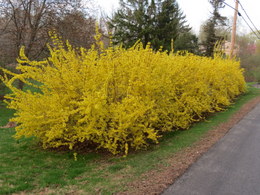Forsythia Growing Guide
Forsythia (Forsythia spp.) is a popular perennial deciduous flowering shrub found in garden centers that generally will do well in USDA Zones 5 to 9. If you live in a colder climate look for other varieties better suited for your USDA Zone. In some of the colder zones the plant will survive, but will not bloom very well. It will do well in full sun to part sun.
Many people want a privacy hedge and plant a row of Arborvitae only to find out that deer will eat it up. It makes a good privacy hedge that is not only deer resistant, but the bright yellow flowers are a welcome sight in the spring time.
There are many varieties ranging from dwarf, variegated and standard. The most common variety is F. x intermedia, but F. ovata, F. suspensa, F. viridissima and others are sold by some specialty online retailers.
If you have a small area, be sure to try one of the low growing, compact dwarf varieties. They make a striking ground cover that produces beautiful yellow flowers in the spring.
Soil Preparation
Plant Forsythia in a full to part sunny location in a nice loose well-drained garden soil.
As soon as the soil is frost-free and can be worked, till the soil by digging down 8 to 12-inches turning the soil over with a garden fork working in some good organic garden soil. Remove any large rocks, the small pebbles remaining will do no harm and actually benefit the soil by adding some micronutrients to the soil.
Forsythia easily adapts and tolerates most acid to alkaline soil conditions. Soil preparation for perennials is important, since they will be in that location a long time.
Planting Forsythia
Plant Forsythia in the late spring after the last expected frost. Follow the grower’s instructions regarding the proper plant spacing. In general, depending on the variety, the spacing can range from 2 to 6-feet.
When planting as a hedge do not place each plant in a straight line. They will look better when planted in a zigzag fashion so that they will grow together and form a dense hedge. When planting along a property line place them far enough on your property so that they do not intrude onto your neighbor’s property. It is always a good idea to check with your neighbor first before planting.
As an attractive free standing lawn specimen place 3-plants properly spaced together as a group.
Dig a hole as deep as the pot and twice as wide. To the soil you just removed add the same amount of good garden soil or compost so you have a nice blend of new and native soil.
Take the plant out of the pot and gently loosen the root ball pulling away any roots that have grown in a circle around the pot.
Place the root ball in the hole with the growing crown of the plant several inches higher than the surrounding soil. Gently spread out the roots and back fill the hole around the root ball leaving a shallow depression around your plant. Fill the depression with water to settle the soil around the roots adding more soil if necessary and water again. Water daily tapering off as the roots grow and get established.
Watering and Care
Forsythia is low maintenance and easy to care for. All you need to do is add a layer of mulch to help retain moisture and keep out competing weeds. They should get an inch of water each week and during dry spells give some water to keep the soil moist.
They usually do not need any fertilizer, but a light side dressing of organic fertilizer such as Espoma Plant-tone can be placed around the plant in the spring.
If left to grow naturally without any pruning, Forsythia can reach 10-feet high and 10-feet wide, depending on the variety.
Forsythia blooms on the canes that grew the previous summer. The next year that cane does not bloom, but the side branches from the main cane bloom. To keep your Forsythia in bloom cut one-third of the canes right to the ground. Do this right after the Forsythia has finished blooming. Try to prune out the oldest canes and keep your Forsythia as symmetrical as you can. In the case of a very large Forsythia shrub that has never been pruned, you can cut off all of the canes 12-inches from the ground while still dormant.
If the Forsythia was a new addition to your landscape give it a few years to get established before heavy pruning.
Forsythia when used as a hedge is easier to care for than a privet hedge, which requires constant pruning to keep it looking good. After blooming give the Forsythia a trim and then again in late July or early August. This will give the new growth the time it needs, to harden off before the first frost in the fall. It will also tolerate a little more shade than privet does.
Diseases and Pests
Forsythia does not have any serious diseases or pests.
Popular Varieties
Popular Varieties: Arnold Dwarf, Bronxensis, Citrus Swizzle, Dwarf Forsythia, Fiesta, Gold Cluster, Gold Tide, Intermedia, Kumson, Lynwood Gold, Meadowlark, Mindor, New Hampshire Gold, Northern Gold, Show Off, Sugar Baby, Sunrise.
Sources: Nature Hills Nursery, Fast Growing Trees, Jackson & Perkins.
Garden Spikes newsletters give you timely information once or twice a month. Subscribe Free to the Garden Times newsletter below.
Your email address will only be used to send you a newsletter and will never be sold. You can unsubscribe at any time.

